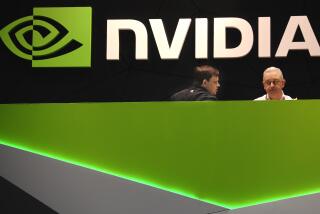Intel Sees Sales Rise, Profit Slip
- Share via
Computer chip giant Intel Corp. said Tuesday that strong worldwide demand and holiday sales of notebook computers pushed fiscal fourth-quarter sales up about 10% and issued a first-quarter forecast that exceeded analysts’ expectations.
Intel’s quarterly revenue was $9.6 billion, up from $8.7 billion the year before. Profit fell 2% to $2.12 billion, or 33 cents a share, from $2.17 billion, or 33 cents, for the same period a year ago. The Santa Clara, Calif.-based company, forecasting a good year ahead, described the profit dip as temporary.
“We ended 2004 with record revenues and robust demand” across markets and product lines, Intel Chief Executive Craig Barrett said.
Industry experts were generally upbeat about the company’s results for the period ended Dec. 25 and Intel’s prospects in the new year.
“I see chip demand as still fairly strong across the board” in 2005, said Michael Cohen, an analyst with Pacific American Securities. “I’d say Intel’s results bode very well for the semiconductor sector as a whole.”
For the first quarter of 2005, revenue is expected to be $8.8 billion to $9.4 billion, Intel Chief Financial Officer Andy Bryant said in a conference call with analysts.
That compares with revenue of $8.1 billion in the first quarter of last year, and $8.9 billion analysts were expecting for the current quarter.
Intel shares, which fell 34 cents to $22.54 in regular Nasdaq trading Tuesday, rose to more than $23 in after-hours trading following the earnings announcement.
Doug Friedman, an analyst in San Francisco with brokerage American Technology Research, noted that some forecasts have chip sales up 5% this year. Based on Intel’s comments Tuesday, the company’s profit for the first quarter “could potentially grow 10%,” he said.
In 2004, Intel earned $7.5 billion, or $1.16 a share, up from $5.6 billion, or 85 cents, in 2003. Full-year sales were $34.2 billion, up 13.6% from 2003.
A buildup of inventory over the last two quarters had been a burden on Intel’s gross profit margin. The company throttled back its operations in the fourth quarter as a result.
“It’s sort of a mixed bag,” Cohen said. “The reason earnings were low was because they lowered plant production in order to burn inventory, which raised costs and lowered the margins. The good side is now the inventory issue is behind them.”
But shares of Advanced Micro Devices Inc., Intel’s main U.S. rival for microprocessors and flash memory, plunged $5.27, or 26%, to $14.86 on the New York Stock Exchange after the company warned that operating profit fell in the fourth quarter as sales of flash-memory chips used in cellphones declined.
“Intel is retaking market share,” Friedman said. “Intel used to be the No. 1 flash supplier for cellphones, then it raised prices and lost share. Now they’ve gotten more aggressive with flash pricing to retake market share.”
About a year ago, Sunnyvale, Calif.-based AMD gained much of the business in flash memory -- silicon that retains data even when devices are turned off -- that Intel lost when it raised prices, but the tide is now turning back in Intel’s favor.
Although Intel’s flash-memory sales were up, the company’s earnings report Tuesday pointed more significantly to “across-the-board strength,” partly because of strong holiday sales for computer makers such as Dell Inc. and Gateway Inc., Friedman said.





